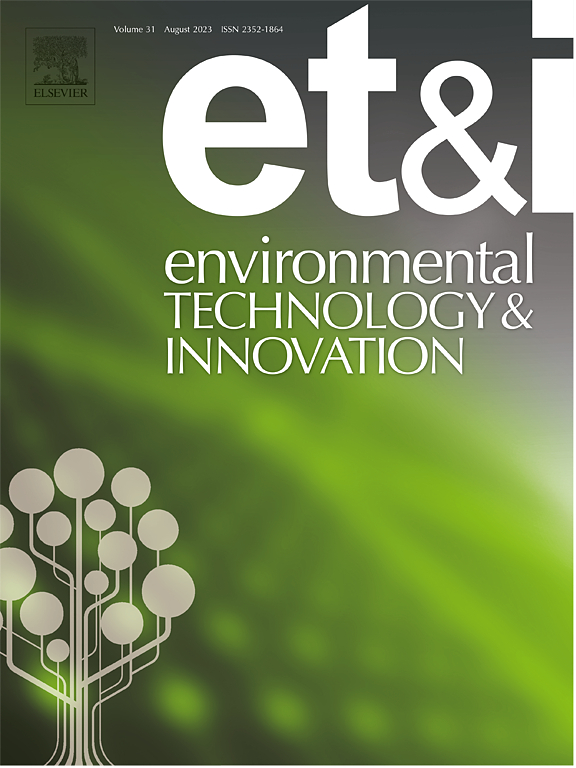How do wheat straw and sulfate application drive redox state and microbial communities to impact sulfur transformation in waterlogged paddy soils?
IF 6.7
2区 环境科学与生态学
Q1 BIOTECHNOLOGY & APPLIED MICROBIOLOGY
引用次数: 0
Abstract
Sulfur (S) is essential for rice growth and plays a pivotal role in soil pollution remediation. Wheat straw (W) amendment and sulfate (SO42-) fertilization are common agricultural practices in rice cultivation, yet their combined effects on S transformation, including organic sulfur (OS), available sulfate (AS), and reduced inorganic sulfur (RIS), in waterlogged paddy soils remain poorly understood. We conducted a 162-day incubation experiment with different W levels (0 %, 0.1 %, 0.5 %, and 1.0 %, w/w) and S rates (0 and 30 mg·sulfur·kg⁻¹, as SO₄²⁻) in flooded soil. The results demonstrated that both W and S applications alone enhanced RIS formation, and their co-application exhibited synergistic effects. Compared to the control, the co-application of W and S increased the proportion of RIS in total S by 76 % (90 %), 70 % (54 %), and 94 % (65 %) with 0.1 %, 0.5 %, and 1.0 % W at the early (middle) stages of incubation, respectively. The increase of RIS was attributed to the enhanced reduction of iron oxides and SO42-, mediated by reducing bacteria (especially Fe reducing bacteria) under low pe + pH. Besides, W addition increased AS levels during the early stage irrespective of S application, especially at 1 % W, due to organic sulfate mineralization. In addition, the influence of W and S applications on S transformation diminished over time. These findings suggest that the co-application of W and S under waterlogged soil could optimize sulfate bioavailability and RIS formation, which could meet the demand of rice sulfur nutrition and contribute to soil pollution remediation.
小麦秸秆和硫酸盐施用如何驱动氧化还原状态和微生物群落影响水淹水稻土的硫转化?
硫(S)是水稻生长所必需的,在土壤污染修复中起着关键作用。小麦秸秆(W)改良和硫酸盐(SO42-)施肥是水稻种植中常见的农业做法,但它们对水淹水稻土中硫转化(包括有机硫(OS)、有效硫酸盐(AS)和还原性无机硫(RIS))的综合影响尚不清楚。我们在淹水土壤中进行了为期162天的不同W(0 %,0.1 %,0.5 %,1.0 %,W / W)和S(0和30 mg·硫·kg⁻,如SO₄²)的培养实验。结果表明,单独施W和S均能促进RIS的形成,而两者共同施W和S则表现出协同效应。控制相比,W和S的co-application RIS的比例增加76年代 %(90 %),70年 %(54 %),和94年 %(65 %)0.1 %, % 0.5和1.0 % W在早期(中)孵化阶段,分别。RIS的增加是由于在低pe + pH条件下,还原性细菌(尤其是铁还原性细菌)介导氧化铁和SO42-的还原作用增强所致。此外,由于有机硫酸盐矿化作用,添加W在早期增加了AS水平,与施S无关,特别是在1 % W时。此外,W和S对S转化的影响随着时间的推移而减弱。综上所述,涝渍土壤下W和S配施可优化硫酸盐的生物有效性和RIS的形成,满足水稻对硫营养的需求,有利于土壤污染修复。
本文章由计算机程序翻译,如有差异,请以英文原文为准。
求助全文
约1分钟内获得全文
求助全文
来源期刊

Environmental Technology & Innovation
Environmental Science-General Environmental Science
CiteScore
14.00
自引率
4.20%
发文量
435
审稿时长
74 days
期刊介绍:
Environmental Technology & Innovation adopts a challenge-oriented approach to solutions by integrating natural sciences to promote a sustainable future. The journal aims to foster the creation and development of innovative products, technologies, and ideas that enhance the environment, with impacts across soil, air, water, and food in rural and urban areas.
As a platform for disseminating scientific evidence for environmental protection and sustainable development, the journal emphasizes fundamental science, methodologies, tools, techniques, and policy considerations. It emphasizes the importance of science and technology in environmental benefits, including smarter, cleaner technologies for environmental protection, more efficient resource processing methods, and the evidence supporting their effectiveness.
 求助内容:
求助内容: 应助结果提醒方式:
应助结果提醒方式:


